coolant reservoir BUICK LACROSSE 2013 Owner's Manual
[x] Cancel search | Manufacturer: BUICK, Model Year: 2013, Model line: LACROSSE, Model: BUICK LACROSSE 2013Pages: 422, PDF Size: 5.74 MB
Page 267 of 422
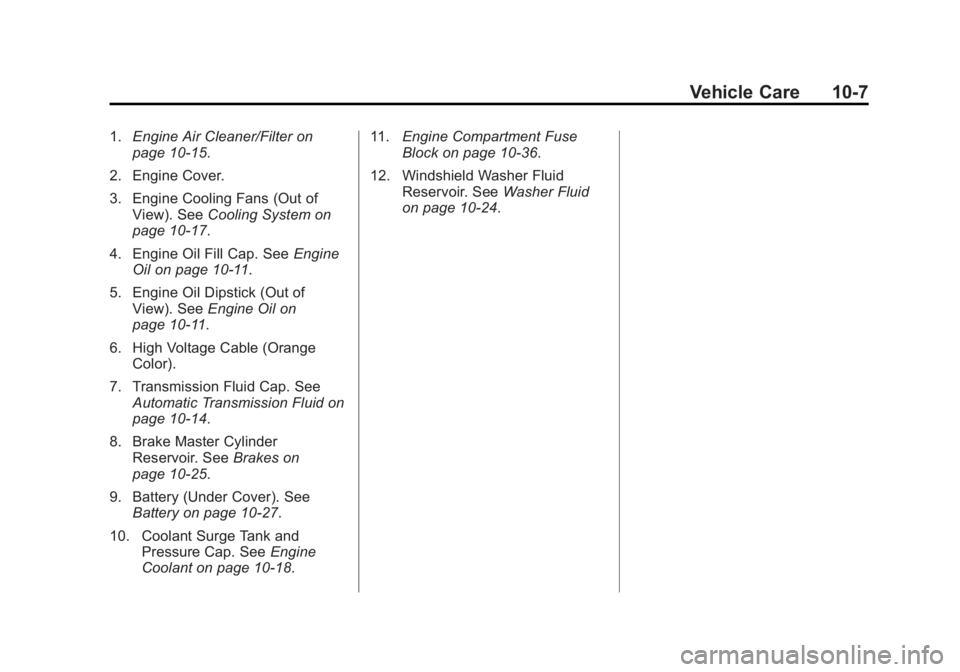
Black plate (7,1)Buick LaCrosse Owner Manual - 2013 - crc - 9/7/12
Vehicle Care 10-7
1.Engine Air Cleaner/Filter on
page 10‑15.
2. Engine Cover.
3. Engine Cooling Fans (Out of View). See Cooling System on
page 10‑17.
4. Engine Oil Fill Cap. See Engine
Oil on page 10‑11.
5. Engine Oil Dipstick (Out of View). See Engine Oil on
page 10‑11.
6. High Voltage Cable (Orange Color).
7. Transmission Fluid Cap. See Automatic Transmission Fluid on
page 10‑14.
8. Brake Master Cylinder Reservoir. See Brakes on
page 10‑25.
9. Battery (Under Cover). See Battery on page 10‑27.
10. Coolant Surge Tank and Pressure Cap. See Engine
Coolant on page 10‑18. 11.
Engine Compartment Fuse
Block on page 10‑36.
12. Windshield Washer Fluid Reservoir. See Washer Fluid
on page 10‑24.
Page 269 of 422
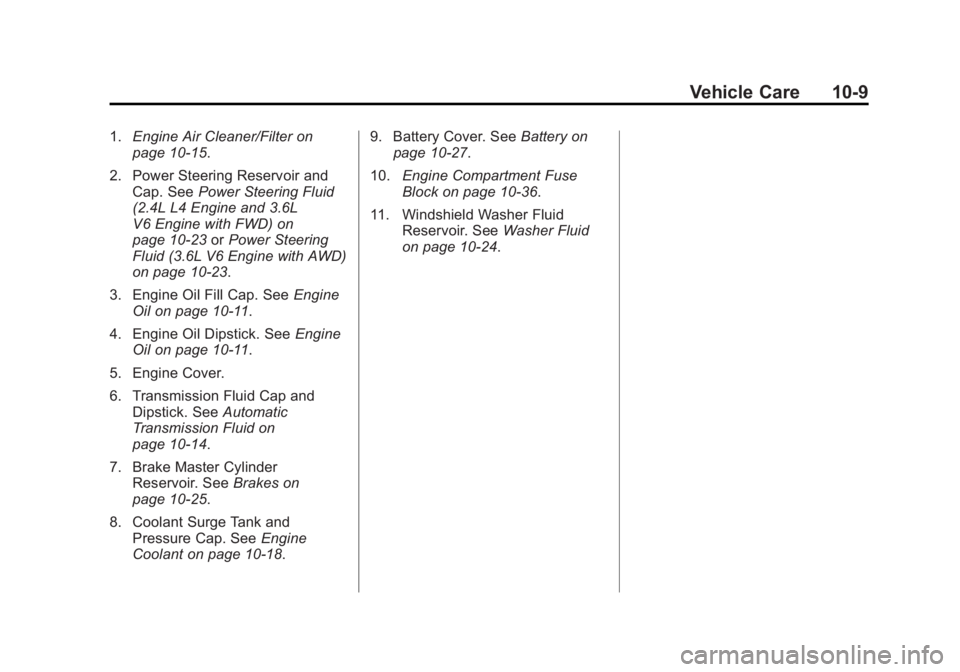
Black plate (9,1)Buick LaCrosse Owner Manual - 2013 - crc - 9/7/12
Vehicle Care 10-9
1.Engine Air Cleaner/Filter on
page 10‑15.
2. Power Steering Reservoir and Cap. See Power Steering Fluid
(2.4L L4 Engine and 3.6L
V6 Engine with FWD) on
page 10‑23 orPower Steering
Fluid (3.6L V6 Engine with AWD)
on page 10‑23.
3. Engine Oil Fill Cap. See Engine
Oil on page 10‑11.
4. Engine Oil Dipstick. See Engine
Oil on page 10‑11.
5. Engine Cover.
6. Transmission Fluid Cap and Dipstick. See Automatic
Transmission Fluid on
page 10‑14.
7. Brake Master Cylinder Reservoir. See Brakes on
page 10‑25.
8. Coolant Surge Tank and Pressure Cap. See Engine
Coolant on page 10‑18. 9. Battery Cover. See
Battery on
page 10‑27.
10. Engine Compartment Fuse
Block on page 10‑36.
11. Windshield Washer Fluid Reservoir. See Washer Fluid
on page 10‑24.
Page 271 of 422
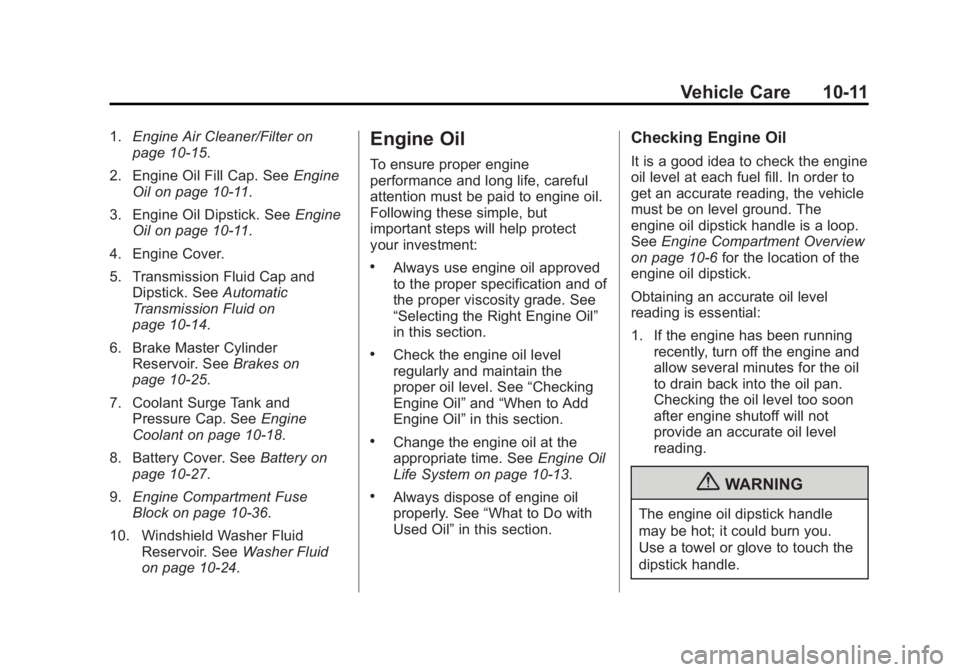
Black plate (11,1)Buick LaCrosse Owner Manual - 2013 - crc - 9/7/12
Vehicle Care 10-11
1.Engine Air Cleaner/Filter on
page 10‑15.
2. Engine Oil Fill Cap. See Engine
Oil on page 10‑11.
3. Engine Oil Dipstick. See Engine
Oil on page 10‑11.
4. Engine Cover.
5. Transmission Fluid Cap and Dipstick. See Automatic
Transmission Fluid on
page 10‑14.
6. Brake Master Cylinder Reservoir. See Brakes on
page 10‑25.
7. Coolant Surge Tank and Pressure Cap. See Engine
Coolant on page 10‑18.
8. Battery Cover. See Battery on
page 10‑27.
9. Engine Compartment Fuse
Block on page 10‑36.
10. Windshield Washer Fluid Reservoir. See Washer Fluid
on page 10‑24.Engine Oil
To ensure proper engine
performance and long life, careful
attention must be paid to engine oil.
Following these simple, but
important steps will help protect
your investment:
.Always use engine oil approved
to the proper specification and of
the proper viscosity grade. See
“Selecting the Right Engine Oil”
in this section.
.Check the engine oil level
regularly and maintain the
proper oil level. See “Checking
Engine Oil” and“When to Add
Engine Oil” in this section.
.Change the engine oil at the
appropriate time. See Engine Oil
Life System on page 10‑13.
.Always dispose of engine oil
properly. See “What to Do with
Used Oil” in this section.
Checking Engine Oil
It is a good idea to check the engine
oil level at each fuel fill. In order to
get an accurate reading, the vehicle
must be on level ground. The
engine oil dipstick handle is a loop.
SeeEngine Compartment Overview
on page 10‑6 for the location of the
engine oil dipstick.
Obtaining an accurate oil level
reading is essential:
1. If the engine has been running recently, turn off the engine and
allow several minutes for the oil
to drain back into the oil pan.
Checking the oil level too soon
after engine shutoff will not
provide an accurate oil level
reading.
{WARNING
The engine oil dipstick handle
may be hot; it could burn you.
Use a towel or glove to touch the
dipstick handle.
Page 283 of 422
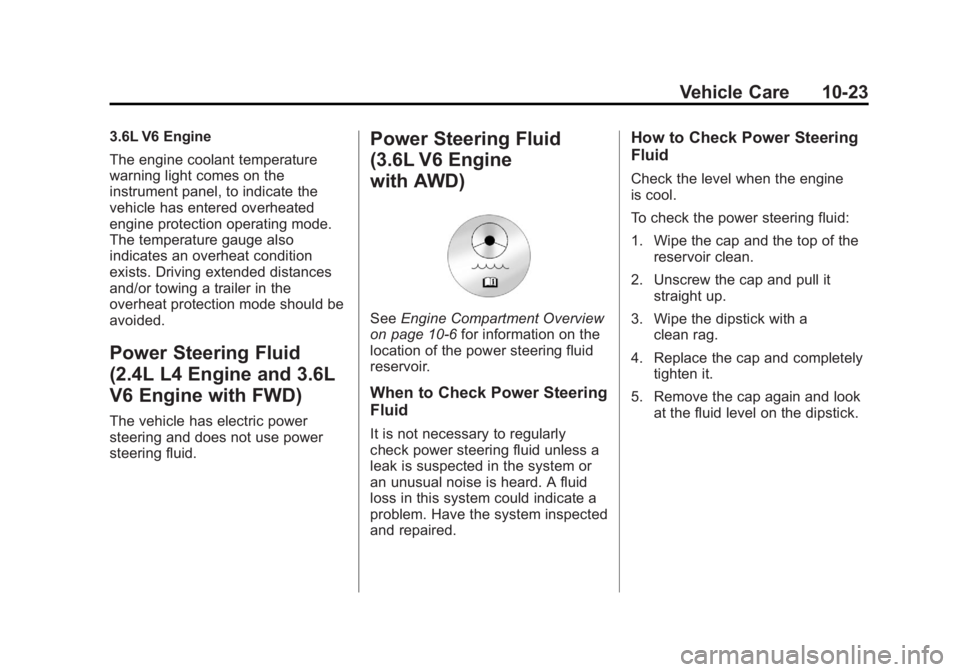
Black plate (23,1)Buick LaCrosse Owner Manual - 2013 - crc - 9/7/12
Vehicle Care 10-23
3.6L V6 Engine
The engine coolant temperature
warning light comes on the
instrument panel, to indicate the
vehicle has entered overheated
engine protection operating mode.
The temperature gauge also
indicates an overheat condition
exists. Driving extended distances
and/or towing a trailer in the
overheat protection mode should be
avoided.
Power Steering Fluid
(2.4L L4 Engine and 3.6L
V6 Engine with FWD)
The vehicle has electric power
steering and does not use power
steering fluid.
Power Steering Fluid
(3.6L V6 Engine
with AWD)
SeeEngine Compartment Overview
on page 10‑6 for information on the
location of the power steering fluid
reservoir.
When to Check Power Steering
Fluid
It is not necessary to regularly
check power steering fluid unless a
leak is suspected in the system or
an unusual noise is heard. A fluid
loss in this system could indicate a
problem. Have the system inspected
and repaired.
How to Check Power Steering
Fluid
Check the level when the engine
is cool.
To check the power steering fluid:
1. Wipe the cap and the top of the reservoir clean.
2. Unscrew the cap and pull it straight up.
3. Wipe the dipstick with a clean rag.
4. Replace the cap and completely tighten it.
5. Remove the cap again and look at the fluid level on the dipstick.
Page 284 of 422
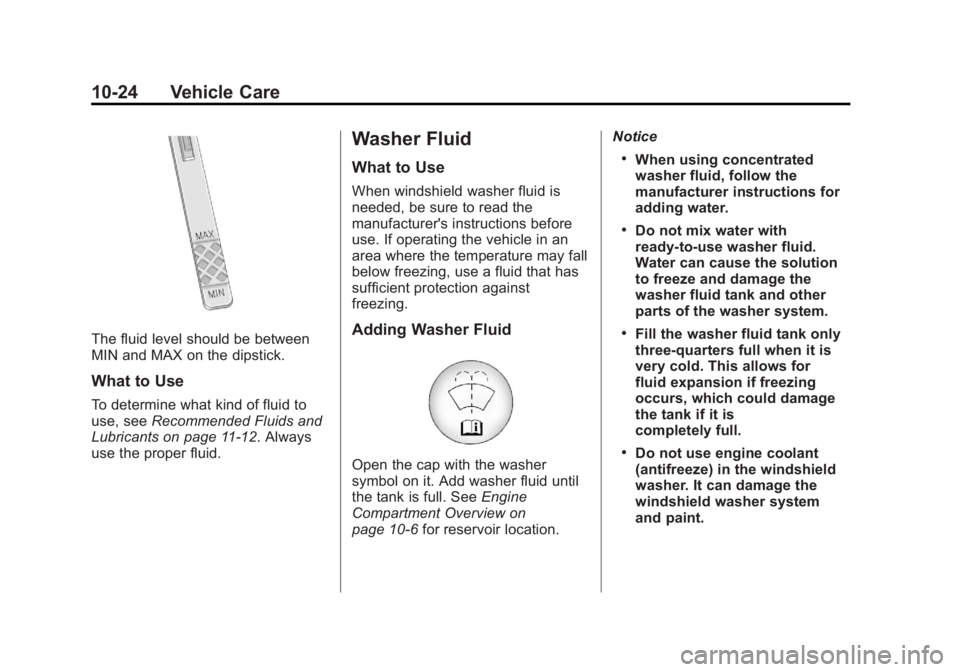
Black plate (24,1)Buick LaCrosse Owner Manual - 2013 - crc - 9/7/12
10-24 Vehicle Care
The fluid level should be between
MIN and MAX on the dipstick.
What to Use
To determine what kind of fluid to
use, seeRecommended Fluids and
Lubricants on page 11‑12. Always
use the proper fluid.
Washer Fluid
What to Use
When windshield washer fluid is
needed, be sure to read the
manufacturer's instructions before
use. If operating the vehicle in an
area where the temperature may fall
below freezing, use a fluid that has
sufficient protection against
freezing.
Adding Washer Fluid
Open the cap with the washer
symbol on it. Add washer fluid until
the tank is full. See Engine
Compartment Overview on
page 10‑6 for reservoir location. Notice
.When using concentrated
washer fluid, follow the
manufacturer instructions for
adding water.
.Do not mix water with
ready-to-use washer fluid.
Water can cause the solution
to freeze and damage the
washer fluid tank and other
parts of the washer system.
.Fill the washer fluid tank only
three-quarters full when it is
very cold. This allows for
fluid expansion if freezing
occurs, which could damage
the tank if it is
completely full.
.Do not use engine coolant
(antifreeze) in the windshield
washer. It can damage the
windshield washer system
and paint.